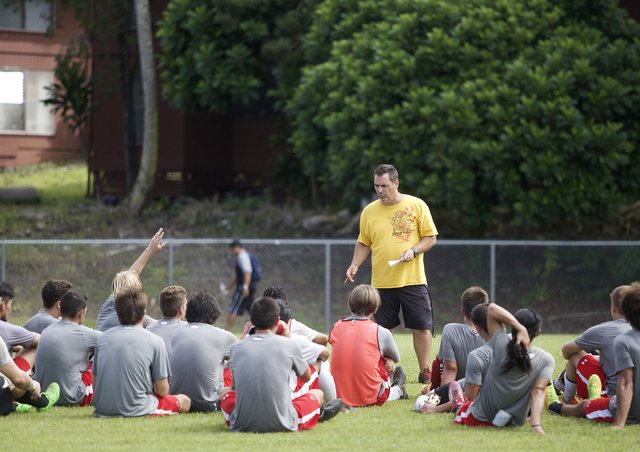They packed everything away until next year, all the bats and balls, the volleyball nets, soccer goals and all the rest. Some of the coaches are watching state high school tournaments, trying to spot a recruit who may have avoided
They packed everything away until next year, all the bats and balls, the volleyball nets, soccer goals and all the rest. Some of the coaches are watching state high school tournaments, trying to spot a recruit who may have avoided their gaze, other coaches are taking time off.
The athletic department at the University of Hawaii at Hilo is almost vacant this time of year, a relative ghost town by comparison to the hub of activity it has been since last August.
Almost, that is, except for the elephant in the room, the elephant that administrators prefer the public doesn’t see, but it is an elephant each of the 220 athletes involved in the 12 sports are aware of, an elephant that each of the 11 coaches may think about more than the students.
Wait, 12 teams but 11 coaches? How does that work out?
At the moment, it is still working, but even an administrator would have to agree the athletic department has a double standard that is easy to explain while remaining very difficult to justify.
UH Hilo is one of four schools in the Pacific West Conference that has one coach for both men’s and women’s soccer, sports that are played in the same fall season.
The soccer program includes more athletes than any other sport the school fields, as many as 45 or so on the final roster, 60 or more when practices open, yet it allocates the fewest paid coaches — one — to instruct those students.
The double standard is a holdover from decades ago when soccer was considered an “emerging” sport, something little kids played in the United States that may or may not grow into a serious sport worthy of the attention afforded to, say, basketball.
It was a consequence of timing and finances. Soccer was a little kick ball sport anyone could play, no need for a coach for men and women, so they opted for a caretaker role.
Wouldn’t it be more accurate for the schools that have one coach for two teams to simply say, “Sorry, we can’t afford two coaches?”
Trouble with that is when you make that statement you admit the administration literally doesn’t believe soccer is worth a coach for both teams and that’s an awfully destructive message to send.
Can you imagine one basketball coach for both teams at a school? Why not, there are only five players on the court at a time, whereas soccer has 11?
Nobody would suggest such a thing because it is obvious that the teaching and coaching would get spread too thin, you really can’t expect someone to do twice the work all on his or her own, unless the sport is soccer.
In this state, BYU-Hawaii is the only other school with one soccer coach, but there’s a catch. The 2016-17 season will be the last season for all athletics at BYU-H, which will leave the Vulcans, Holy Names and Notre Dame de Namur as the only three schools that ask one person to coach both teams.
There’s a catch there, too. Recruiting is the biggest success factor in any sport, and if you coach soccer at one of those two Northern California schools, a tank of gas and a serviceable means of transport can bring you closer to a wealth of recruits in an hour or two than 20 times that money can get you in Hilo. First, a plane flight to California is necessary, then a rental car, a hotel room and with enough work, a soccer coach can eventually get to the same recruits the teams they coach against have in their backyards. Then, they have to convince them a five-hour flight at their cost will be worth it to see the school in person.
There’s something to be said for the challenge of coaching two teams, for some coaches. When UHH athletics director Pat Guillen was at Cal-State Dominguez Hills, the soccer coach won a national championship with the men’s team and a year later got the women’s team to a national final. In all, he won two men’s titles before the school hired a second coach for the women’s team.
Anecdotal evidence is always interesting to consider but it seldom forms a representative example that applies to all when common sense patiently lobbies for equality.
Soccer has long since passed the point of being considered an “emerging” sport, its ‘sell-by’ date was, oh, maybe a decade ago, more likely two decades ago.
Here’s hoping the administration will visit the issue seriously. The students deserve more than a double standard, and it’s time the school realizes that is truly the emerging issue in the athletic department.
(Contact Bart at barttribuneherald@gmail.com with questions or comments)



